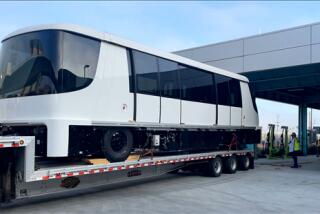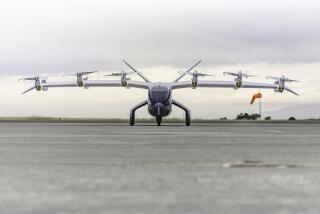Clifton Moore, 80; ‘Mr. Aviation’ Helped LAX Grow
Clifton A. Moore, who earned the nickname “Mr. Aviation” for overseeing the transformation of Los Angeles International Airport into the world’s third-busiest transportation hub and for his leadership role in civil aviation, has died. He was 80.
Moore, who retired as executive director of the Los Angeles Department of Airports in 1993 after more than two decades on the job, died Monday of undisclosed causes at a hospital in Lancaster.
A self-educated man who had to decline a scholarship to the Massachusetts Institute of Technology to help support his family during the Depression, Moore got his first job with the city as an electrician in 1946. Among his duties was climbing atop City Hall to repair the beacon that illuminated what was then the tallest building in Los Angeles and that guided airplanes to the city’s small commercial airport 17 miles away.
When he retired from the Department of Airports, Moore left what was then the highest-paying job in city government, with an annual salary of $181,812, and an international reputation in the field of aviation.
As the department’s executive director, Moore helped build an airport that was instrumental in Los Angeles’ growth as a tourist and business destination.
Under his leadership, LAX underwent a $750-million expansion that was completed in June 1984--in time for the influx of visitors to the Los Angeles Olympic Games. The expansion included a second-level roadway separating departure and arrival traffic, two new terminals and three new parking structures.
Three years earlier, Moore helped establish the Regional Airport Authority for Southern California to develop long-range plans for the region’s airport system.
Among his responsibilities with the Department of Airports was overseeing the day-to-day operations of Van Nuys Airport, Ontario International Airport and Palmdale Regional Airport.
“As Mr. Airport in Southern California from the ‘60s to the ‘90s, Clif Moore recognized better than anyone the importance of an airport system to the city and the region,” said Lydia H. Kennard, executive director of Los Angeles World Airports, as the Department of Airports is now known.
“As demand for air passenger transportation increased dramatically over four decades,” Kennard said, “he worked tirelessly to ensure Los Angeles became the premier international air gateway on the West Coast while preparing the city’s airports in Palmdale, Ontario and Van Nuys to help meet the demand for air service in Southern California.”
“He was the first guy who understood way back in the 1960s that Los Angeles air travel was going to outgrow LAX--that it’s important to be prepared to grow aviation somewhere else,” said Councilwoman Ruth Galanter, whose district includes the airport.
“He was Mr. LAX,” said Johnnie L. Cochran Jr., who served on the Airport Commission in the ‘80s and early ‘90s. “What you see out there now, the new LAX, is the result of the vision of Clif Moore.”
In Moore’s frequent travels around the world to promote LAX, Cochran said, “he helped us grow overseas and boost the cargo tonnage [at LAX]. He understood that LAX is the engine that drove the economy for Southern California.”
When Moore announced his retirement, then-Mayor Tom Bradley praised him for helping make LAX a major contributor to the city’s economic vitality.
“In 1976, the airport generated only $7.4 billion in our local economy,” Bradley said. “In 1990, the airport was responsible for infusing $37 billion in our local economy. More than 400,000 jobs are produced by our airport.”
Cochran, who as an airport commissioner occasionally accompanied Moore on his overseas trips, said Moore was acknowledged abroad as “Mr. Aviation.” And on those occasions when the mayor accompanied them, Cochran said, officials “didn’t know who to honor first. [Moore] had the stature around the world.”
Moore was born in Jamaica Plain, Mass., in 1922, the son of an electrician for the city of Boston who died when Moore was 10. After declining the MIT scholarship, Moore was unable to find a job, so he joined the Navy in 1940.
At 20, he became the youngest petty officer in Navy history. A chief electrician’s mate, he was aboard the destroyer Warden in Pearl Harbor on Dec. 7, 1941, when the Japanese attacked.
After four years of sea duty in the Pacific and the North Atlantic, Moore settled in Los Angeles, where he got the electrician’s job.
In the mid-1950s, after working for the Culver City school district as director of building and maintenance, Moore took a competitive examination for building superintendent with the Los Angeles Department of Airports.
He scored the highest and got the job to supervise construction of the airport’s first jet terminal, which opened in 1961.
Five years later, Moore was named first deputy general manager of the Department of Airports, and in 1968 the Airport Commission chose him to become general manager, a title later changed to executive director.
“I’m one of the examples of civil service that show you can start way down here and end up here,” Moore told The Times in 1976, raising his hand from one level to another. “I would hope that would inspire others.”
During his 24-year tenure, the affable Moore dealt with residents’ complaints over deafening jet noise and airport expansion.
Irate homeowners weren’t his only critics. There were those in City Hall who referred to him as “Marco Polo” because of his constant traveling.
Once, when he was not present for a City Council committee meeting, Councilman Robert M. Wilkinson asked sarcastically, “Is he visiting Los Angeles now?”
Moore defended his travels as necessary to keep air commerce “a viable part of our municipal life.”
Moore would travel to Montreal or Paris to confer with aviation officials over international landing agreements, or he would be in Sacramento or Washington, D.C., to testify before legislative committees.
Much of that, he explained in 1976, was because he was president of the Airport Operators Council International, which had been working to reduce jet noise--particularly at its source, the engine.
“The biggest problem on this job,” Moore said at the time, “is trying to bring about a satisfactory resolution of the jet noise problem without depriving the area of the service or putting a burden on the economy.”
Moore’s colleagues, who described him as highly approachable, were impressed by his refusal to adopt top-executive mannerisms. Whereas department officials who worked for Moore had their offices redecorated over the years, he maintained the same functional look his office had when he moved in.
And in 1988, he was still driving the city-owned Chevrolet sedan he had used for 11 years.
Moore also earned a reputation for being what one employee called “a very moral man”: He would scrutinize computer printouts of the department telephone bills, adding up all his personal calls so he could pay for them.
Moore served two terms as president of the International Civil Airports Assn., an organization of more than 250 major airports around the world.
He is survived by his wife of 60 years, Betty; son Steven of Fountain Valley; two daughters, Kerry Brice of Oakhurst, Calif., and Dale Norman of Santa Monica; and six grandchildren.
Funeral service arrangements were pending.
More to Read
Sign up for Essential California
The most important California stories and recommendations in your inbox every morning.
You may occasionally receive promotional content from the Los Angeles Times.









